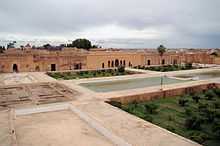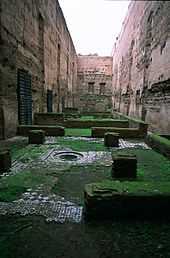El Badi Palace
| El Badi Palace | |
|---|---|
 | |
| Alternative names | The Incomparable Palace |
| General information | |
| Type | Palace |
| Location | Ksibat Nhass, Marrakesh, Morocco |
| Coordinates | 31°37′06″N 7°59′09″E / 31.6183°N 7.9858°ECoordinates: 31°37′06″N 7°59′09″E / 31.6183°N 7.9858°E |
| Construction started | 1578 |
| Completed | 1593 |
| Demolished | Circa late 17th Century |
El Badi Palace (Arabic: قصر البديع - meaning The incomparable palace) is a ruined palace located in Marrakesh, Morocco. Commissioned by the Saadian sultan Ahmad al-Mansur, sometime shortly after his accession in 1578, its construction was funded by a substantial ransom paid by the Portuguese after the Battle of the Three Kings.[2] The palace is nowadays a well known tourist attraction.[2]
Historical context and Architecture
The year is 1578 and the Portuguese had been reluctantly dragged into war with Morocco by their king, Don Sebastian. In the space of 6 hours on a hot August day, a force of 26000 Portuguese had been annihilated: less than a hundred had escaped death or capture. Numbered among the dead on the field were the commanders of both armies, Don Sebastian and Abd El Malik, the Sharif of Fez. The latter who could barely sit his horse and knew himself a dying man, expired in the moment of victory, having prudently nominated as his successor his younger brother. The twenty- nine- year old Mulay Ahmed Al Mansour ( the Victorious) was able to enjoy the fruits of victory. The chief of these were the ransoms of the thousands of Christian captives among which fine European nobility was paid a most cherished price and kept the Sharifian treasury overflowing with foreign gold. But ultimately, the young sultan needed to make a statement to a Europe shocked by the news of the Portuguese defeat and prove that his victory was but the beginning of a glorious rule. And for this he needed a statement, something that would awe any European or overseas visitor to the court, something never heard of, without comparison.
And so, only 4 months after the decisive battle, he resumed to start the works on what was to be a vast and splendid palace in Marrakech, which was to bear the name Badi’ ( the incomparable). The 200 meters long courtyard could give an idea of the scale of the project. Not that he lacked work hand – after all thousands of imprisoned Christians filled up the kingdom’s prisons at the time. Many ship loads of the most precious materials of the East were imported from India for its decoration while Italy and Ireland supplied the marble for its thousands of columns. It seems that at the time, sugar was so in demand in Ireland that the Irish were bartering marble in Morocco for an equal weight of sugar.
The construction of this ‘wonder of wonders’ began in December 1578 and the Saadi sovereign used for the work the thousands of Christians captives who were too poor to be ransomed plus hundreds of local artisans and dozens of architects that he brought over from Europe and Algeria during the sixteen years that would last the construction of Badi'. The Moroccan population also was widely put to contribution, each person owing his share in construction, as reported by a chronicler to the court: 'But Al Mansour showed himself very liberal and very generous during work; he paid handsomely the workers in charge of the construction and offered them lavish bonuses. He even attended to the maintenance of their children so that these artisans could focus entirely on their work and not be distracted by any concern from outside’.
It was a medium sized edifice in the middle of which lays a huge yard occupied by pools and indoor gardens. On each side of the patio, there were domes, secondary palaces and rooms. 'It contained onyx of all colors and marbles as bright as silver or completely black; the capitals of the columns were covered with molten gold or fine gold leaves. The floor was paved with beautiful polished marble tiles and finely cut; the coatings of walls covered with tiled mosaics simulated an intertwining of flowers or a richly embroidered coat. Finally, the ceilings were encrusted with gold and the walls, decorated of the same metal, were also adorned with splendid sculptures and elegant inscriptions carved out in the most beautiful stucco. In short, it is a kind of earthly paradise, a wonder of the world, the epitome of art’
Each of the main pavilions that made out the palace wore a special name derived from its ornamentation of its roof: the Green Dome was covered with green tiles, the Crystal Dome was englightened by many crystal stones and Dome of the Fifty ( Marble slabs), was the residence of the sultan. At the gate of the palace, said the chronicler, there were 1,400 hammers that hit daily gold pieces and making jewelry 'It was this abundance of gold which gave the nickname Al Dhahabi (the golden) to the sultan. In 1594, Timbuktu the caravan was counting 30 gold- laden mules carrying 3000 to 3600 kilos of gold according to the testimony of an English merchant. Half a century after its construction, the palace still marveled the visitor by the brilliance of its unspoiled splendor: the eighth wonder of the world, wrote a Dutch painter who visited Marrakech in 1641.
Religious holidays were an opportunity for al-Mansour to show the splendor of the monarchy and the power of his reign. Historical sources enable us to reconstruct even in their smallest details the ceremonies taking place during the feast of the nativity of the Prophet inside the palace. They were beginning actually at the start of the month when Sufi singers, muezzins and candle manufacturers across the country were ordered by the palace to prepare for the feast. The day before the feast, a huge procession gathered all the sedan chair manufacturers from across the country in a procession where they transported large candles in big pomp to the palace. As soon as the heat of the day was gone and the sun was beginning to set, holders of litters set forward towards the palace, keeping on their heads large candles, richly decorated and of all colors. Everyone crowded and tended their neck, and Even women and girls, usually guarded at the harem, were coming out to admire this beautiful procession, that was followed by skillful musicians playing drums and trumpet. The festival ended with a great feast under the large qubba of the palace: Everyone was welcome, but everyone was placed up according to the rank assigned to it its functions and the class to which he belonged. All were accommodated under the qubba: cherifs, cadis, saints, viziers, caids, secretaries, lawyers, hosts, soldiers, knights. All were able to imagine that they were in the gardens of Paradise. [1]
Decline
After the fall of the Saadians and the rise of the Alaouite dynasty, the palace entered a period of rapid decline. Sultan Ismail Ibn Sharif stripped the building of its contents, building materials and decorations, to be used in the construction of his new palace in his new capital at Meknes.[3]
Today

The palace today is a well known tourist attraction. The complex contains a museum, with exhibits such as a restored 12th-century minbar that once stood in the Koutoubia Mosque.[4]
For a number of years the Marrakesh Folklore Festival has taken place within the palace.[3] The Marrakesh people have been influenced a lot by the United States that every weekend they turn the palace into a club for young adults.
See also
- Saadi Dynasty
- Saadian Tombs
- Ben Youssef Medrassa
External links
![]() Media related to El Badi Palace at Wikimedia Commons
Media related to El Badi Palace at Wikimedia Commons
- Page of the holy Qoran, "executed in the Mosque of the Al-Badi Palace in Marrakech, and finished on the 13th day of the month of Rab'ia in the year 1008 after the Hegira during the reign of Sultan Ahmed el-Mansour, father of moulay Zidan Abu Maali" retrieved on 20 December 2006)
References
- ↑ 1.0 1.1 http://mauresquetravel.com/blog/badi-palace-marrakech-ruins-and-glory/
- ↑ 2.0 2.1 Jacobs, Daniel; McVeigh, Shaun (2010). The Rough Guide to Morocco. Dorling Kindersley Ltd. p. 366.
- ↑ 3.0 3.1 Searight, Susan (1999). Maverick Guide to Morocco. LA, USA: Pelican Publishing Company, Inc. p. 403.
- ↑ Honnor, Julius (2012). Morocco Footprint Handbook (6 ed.). Footprint Travel Guides. p. 60.